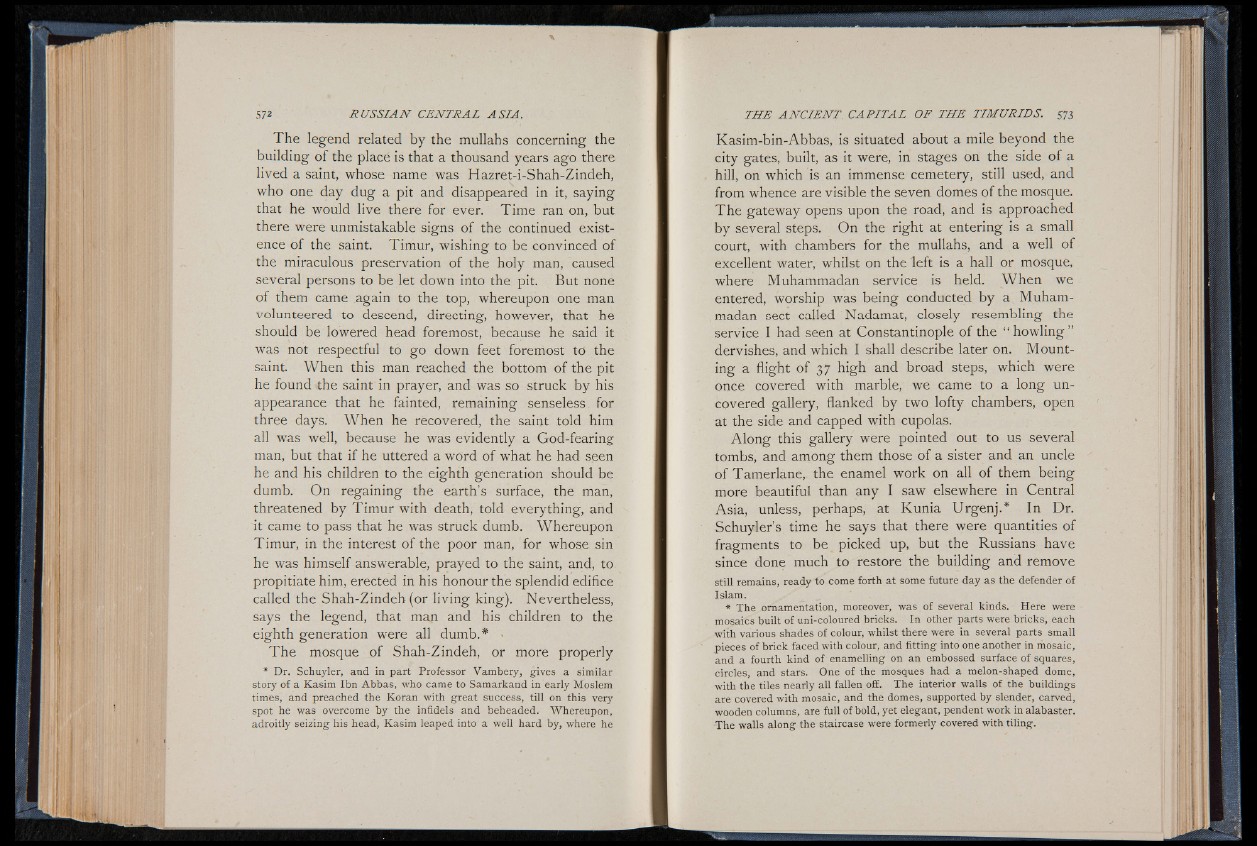
The legend related by the mullahs concerning the
building of the place is that a thousand years ago there
lived a saint, whose name was Hazret-i-Shah-Zindeh,
who one day dug a pit and disappeared in it, saying
that he would live there for ever. Time ran on, but
there were unmistakable signs of the continued existence
of the saint. Timur, wishing to be convinced of
the miraculous preservation of the holy man, caused
several persons to be let down into the pit. But none
of them came again to the top, whereupon one man
volunteered to descend, directing, however, that he
should be lowered head foremost, because he said it
was not respectful to go down feet foremost to the
saint. When this man reached the bottom of the pit
he found the saint in prayer, and was so struck by his
appearance that he fainted, remaining senseless, for
three days. When he recovered, the saint told him
all was well, because he was evidently a God-fearing
man, but that if he uttered a word of what he had seen
he and his children to the eighth generation should be
dumb. On regaining the earth’s surface, the man,
threatened by Timur with death, told everything, and
it came to pass that he was struck dumb. Whereupon
Timur, in the interest of the poor man, for whose sin
he was himself answerable, prayed to the saint, and, to
propitiate him, erected in his honour the splendid edifice
called the Shah-Zindeh (or living king). Nevertheless,
says the legend, that man and his children to the
eighth generation were all dumb.* >
The mosque of Shah-Zindeh, or more properly
* Dr, Schuyler, and in part Professor Vambery, gives a similar
story of a Kasim Ibn Abbas, who came to Samarkand in early Moslem
times, and preached the Koran with great success, till on this very
spot he was overcome by the infidels and beheaded. Whereupon,
adroitly seizing his head, Kasim leaped into a well hard by, where he
Kasim-bin-Abbas, is situated about a mile beyond the
city gates, built, as it were, in stages on the side of a
hill, on which is an immense cemetery, still used, and
from whence are visible the seven domes of the mosque.
The gateway opens upon the road, and is approached
by several steps. On the right at entering is a small
court, with chambers for the mullahs, and a well of
excellent water, whilst on the left is a hall or mosque,
where Muhammadan service is held. When we
entered, worship was being conducted by a Muhammadan
sect called Nadamat, closely resembling the
service I had seen at Constantinople of the “ howling ”
dervishes, and which I shall describe later on. Mounting
a flight of 37 high and broad steps, which were
once covered with marble, we came to a long uncovered
gallery, flanked by two lofty chambers, open
at the side and capped with cupolas.
Along this gallery were pointed out to us several
tombs, and among them those of a sister and an uncle
of Tamerlane, the enamel work on all of them being
more beautiful than any I saw elsewhere in Central
Asia, unless, perhaps, at Kunia Urgenj.* In Dr.
Schuyler’s time he says that there were quantities of
fragments to be picked up, but the Russians have
since done much to restore the building and remove
still remains, ready to come forth at some future day as the defender of
Islam.
* The ornamentation, moreover, was of several kinds. Here were
mosaics built of uni-coloured bricks. In other parts were bricks, each
with various shades of colour, whilst there were in several parts small
pieces of brick faced with colour, and fitting into one another in mosaic,
and a fourth kind of enamelling on an embossed surface of squares,
circles, and stars. One of the mosques had a melon-shaped dome,
with the tiles nearly all fallen off. The interior walls of the buildings
are covered with mosaic, and the domes, supported by slender, carved,
wooden columns, are full of bold, yet elegant, pendent work in alabaster.
The walls along the staircase were formerly covered with tiling.